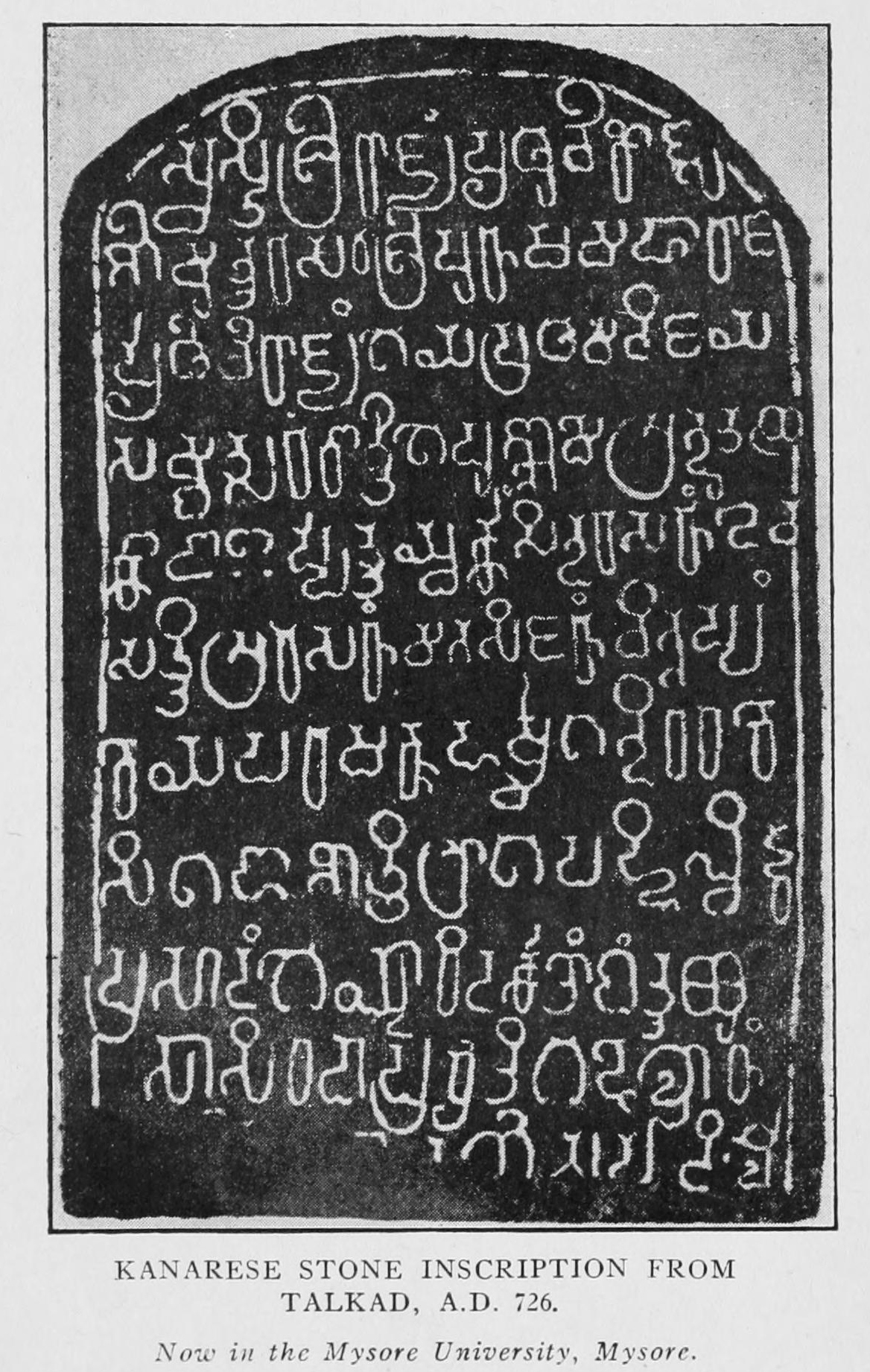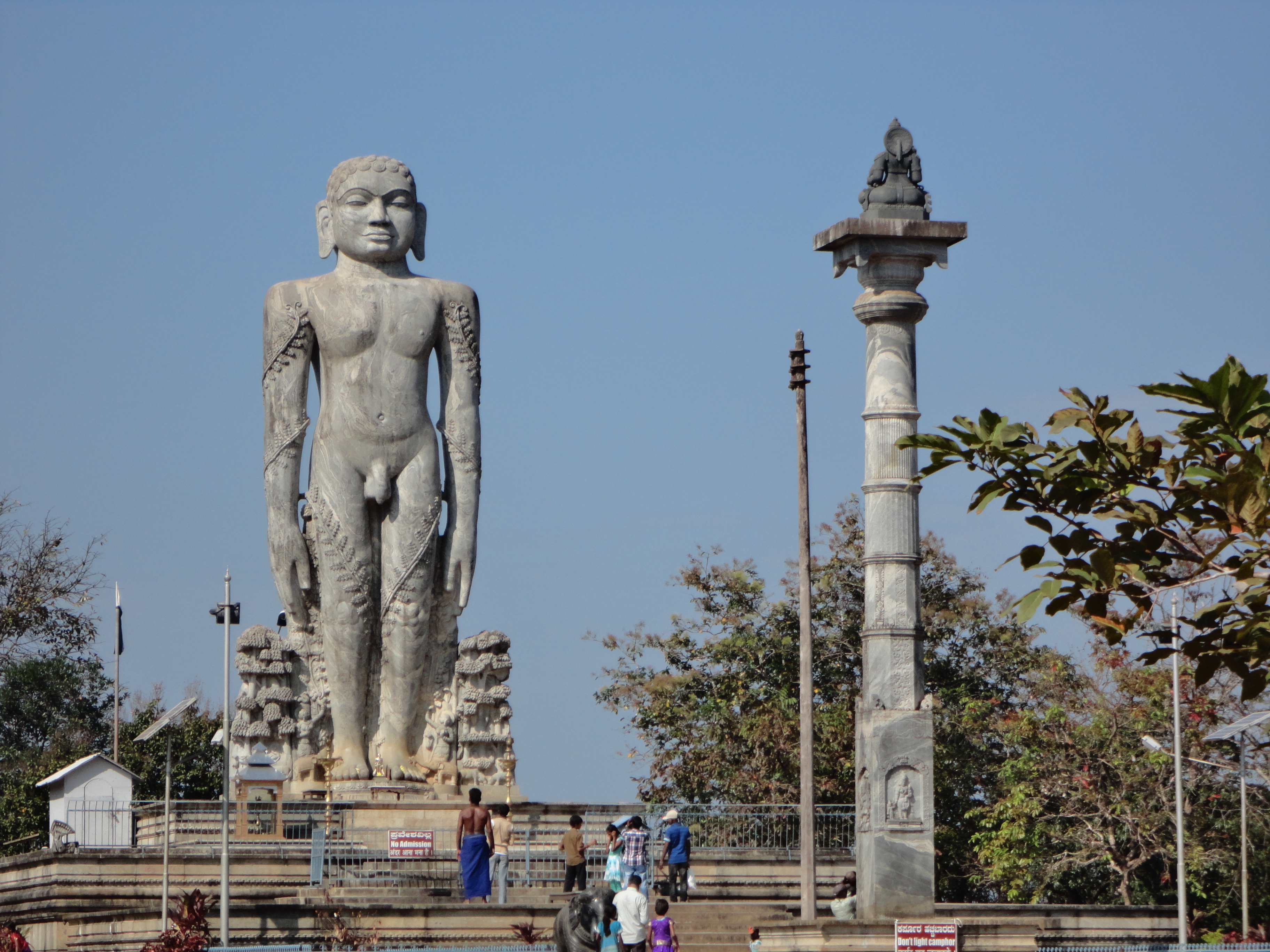|
Chavundaraya
''Cāmuṇḍarāya'' or Chavundaraya (Kannada ''Cāmuṇḍarāya, Cāvuṇḍarāya'', 940–989) was an Indian people, Indian Jain ruler. He served in the court of the Western Ganga dynasty of Talakad (in modern Karnataka, India). A person of many talents, in 981 he commissioned the construction of the monolithic statue of Bahubali, the Gommateshwara statue, Gomateshwara, at Shravanabelagola, an important place of pilgrimage for Jainism. He was a devotee of the Jain Acharya Nemichandra and Ajitasena Bhattaraka and was an influential person during the reigns of Marasimha II Satyavakya, (963–975). Rachamalla IV Satyavakya, (975–986) and Rachamalla V (Rakkasaganga), (986–999). A courageous commander with the title ''Samara Parashurama, Paraśurāma'' (''lit'', "Battle-Rama wielding an ax"), he found time to pursue his literary interests as well and became a renowned writer in Kannada and Sanskrit.Kamath (2001), p45Sastri (1955), pp356-357 He wrote an important and exist ... [...More Info...] [...Related Items...] OR: [Wikipedia] [Google] [Baidu] |
Chavundaraya Basadi
Chavundaraya basadi or Chamundaraya basadi or Boppa-Chaityalya is one of the fifteen Jain temple, basadis (Jainism, Jain temples) located on the Chandragiri Hill in Shravanabelagola in the Indian state of Karnataka. Archaeological Survey of India has listed the Chavundaraya basadi in group of monuments in Shravanabelagola as ''Adarsh Smarak Monument''. History Chavundaraya basadi was erected by Chavundaraya during the reign of Western Ganga dynasty, Ganga King Marasimha II in 982 CE and completed by Chavundaraya's son Jinadeva. The idol of Neminatha, flanked by Chauri bearers, is believed to installed by Hoysala period attributing to the characteristics matching Hoysala art. The temple is also known as ''Sruta-tirtha'' () because 10th century Jain Acharya Nemichandra composed Gommatsāra here. The temple underwent improvement in the 12th century under the rule of Chola Empire. The pyramidal shikhara crowned with domical finial is example of Chola architecture. In , a pillared ... [...More Info...] [...Related Items...] OR: [Wikipedia] [Google] [Baidu] |
Western Ganga Dynasty
Western Ganga was an important ruling dynasty of ancient Karnataka in India which lasted from about 350 to 999 CE. They are known as "Western Gangas" to distinguish them from the Eastern Ganga Dynasty, Eastern Gangas who in later centuries ruled over Kalinga (historical region), Kalinga (modern Odisha and Northern Andhra Pradesh). The general belief is that the Western Gangas began their rule during a time when multiple native clans asserted their freedom due to the weakening of the Pallava empire in South India, a geo-political event sometimes attributed to the southern conquests of Samudra Gupta. The Western Ganga sovereignty lasted from about 350 to 550 CE, initially ruling from Kolar, Karnataka, Kolar and later, moving their capital to Talakadu on the banks of the Kaveri River in modern Mysore district. After the rise of the imperial Chalukya dynasty, Chalukyas of Badami, the Gangas accepted Chalukya overlordship and fought for the cause of their overlords against the Pal ... [...More Info...] [...Related Items...] OR: [Wikipedia] [Google] [Baidu] |
Nemichandra
Nemichandra (fl. c. 975), also known by his epithet Siddhanta Chakravarty, was a Jain acharya from present-day India. He wrote several works including '' Dravyasamgraha'', '' Gommatsāra'' (''Jivakanda'' and ''Karmakanda''), ''Trilokasara'', ''Labdhisara'' and ''Kshapanasara''. Life Nemichandra flourished around 975. He was popularly known as " Nemicandra Siddh ''ā''ntacakravartî" (i.e. the Paramount Lord of the Philosophy). He was the spiritual teacher of ''Cāmuṇḍarāya'' and their relation is expressed in the 1530 inscription in the enclosure of Padmavati temple, Nagar Taluka, Shimoga district. Nemichandra supervised the ''abhisheka'' (consecration) of the Gommateshwara statue (on 13 March 980). Works At the request of Chavundaraya, Nemichandra wrote '' Gommatsāra'' in 10th century, taking the essence of all available works of the great '' Acharyas''. ''Gommatasara'' provides a detailed summary of ''Digambara'' doctorine. He wrote ''Trilokasara'' based on the '' ... [...More Info...] [...Related Items...] OR: [Wikipedia] [Google] [Baidu] |
Bahubali
Bahubali (, ) was the son of Rishabhanatha (the first ''tirthankara'' of Jainism) and the brother of the ''Chakravarti (Sanskrit term), chakravartin'' Bharata (Jainism), Bharata. He is a revered figure in Jainism. He is said to have meditated motionless for 12 years in a standing posture (''kayotsarga''), with climbing plants having grown around his legs. After his 12 years of meditation, he is said to have attained omniscience (''Kevala Jnana, kevala jnana''). Bahubali's other names are Kammateshwara and Gommateshwara, the namesake of the Gommateshwara statue dedicated to him. Legends The ''Adipurana'', a 9th-century Sanskrit poem, deals with the ten lives of the first ''tirthankara'', Rishabhanatha and his two sons Bharata Chakravartin, Bharata and Bahubali. It was composed by Jinasena, a ''Digambara monk''. Family life According to Jain texts, Bahubali was born to Rishabhanatha and Sunanda during the Ikshvaku dynasty in Ayodhya (Ramayana), Ayodhya. He is said to have e ... [...More Info...] [...Related Items...] OR: [Wikipedia] [Google] [Baidu] |
Gommateshwara Statue
The Gommateshwara statue is a high monolithic statue on Vindhyagiri, also known as ''Indra-giri'' in the town of Shravanbelagola in the Indian state of Karnataka. Carved of a single block of granite, it is one of the tallest monolithic statues in the ancient world. The Gommateshwara statue is dedicated to the Jain figure Bahubali and symbolises the Jain precepts of peace, non-violence, sacrifice of worldly affairs, and simple living. It was built around 983 CE during the Western Ganga dynasty and is one of the largest free-standing statues in the world. It was regarded the tallest Jain statue until 2016. The construction of the statue was commissioned by the Ganga dynasty minister and commander Chavundaraya. Neighbouring areas have Jain temples known as ''basadis'' and several images of the Tirthankaras. Vindyagiri Hill is one of the two hills in Shravanabelagola. The other is Chandragiri, which is also a seat of several ancient Jain centres, much older than Gommateshwara ... [...More Info...] [...Related Items...] OR: [Wikipedia] [Google] [Baidu] |
Shravanabelagola
Shravanabelagola (pronunciation: ) is a town located near Channarayapatna of Hassan district in the Indian state of Karnataka and is from Bengaluru. The Gommateshwara Bahubali statue at Shravanabelagola is one of the most important tirthas (pilgrimage destinations) in Jainism, one that reached a peak in architectural and sculptural activity under the patronage of Western Ganga dynasty of Talakad. Chandragupta Maurya is said to have died on the hill of Chandragiri, which is located in Shravanabelagola, in 298 BCE after he became a Jain monk and assumed an ascetic life style. Gommateshwara statue, Akkana Basadi, Chandragupta basadi, Chamundaraya Basadi, Parshvanath Basadi and inscriptions of Shravanabelagola group of monuments are listed as Adarsh Smarak Monument by Archaeological Survey of India. Location Shravanabelagola is located at to the south-east of Channarayapatna in the Channarayapatna taluk of Hassan district of Karnataka. It is at a distance of south- ... [...More Info...] [...Related Items...] OR: [Wikipedia] [Google] [Baidu] |
Ranna (Kannada Poet)
Ranna, was one of the earliest and arguably one of the greatest poets of the Kannada language. His style of writing is often compared to that of Adikavi Pampa who wrote in the early 10th century. Together, Ranna, Adikavi Pampa and Sri Ponna are called "Three gems of ancient Kannada literature". Biography Ranna was a 10th-century Kannada poet. He was born in 949 C.E. in ancient Belagali, known now as Mudhol, RannaBelagali in the Bagalkot district of the modern Karnataka state in India, to a family of bangle sellers. Literature During his early days as a writer, Ranna may have been patronized by Chavundaraya (or Chavundaraya), the famous minister of the Western Ganga Dynasty. With the rise of the imperial Western Chalukya Empire, Ranna became an important poet in the court of King Tailapa II and his successor King Satyashraya who bestowed upon him the title ''Kavi Chakravarti'' (''lit'', "Emperor among poets"). The writings of Ranna are in ''Halegannada'' (''lit'', "old Kannada" ... [...More Info...] [...Related Items...] OR: [Wikipedia] [Google] [Baidu] |
Tyagada Brahmadeva Pillar
The Tyagada Brahmadeva Pillar (or ''Chhagada Brahmadeva Pillar'') is a decorated free standing pillar (''lit'', ''Stambha''), 2.3 m tall, commissioned by Chamundaraya, an important minister and commander in the Western Ganga Dynasty, Western Ganga kingdom, during the rule of King Marasimha II (963–975), Rachamalla IV (975–986) and Rachamalla V.Kamath (1980), p. 45Sarma (1992), p. 153 The pillar dates to around 983 C.E. and exists on the Vindyagiri hill (called ''Dodda Betta'' in local Kannada language) in the important Jain heritage town Shravanabelagola, in the Karnataka state, India.Kamath (1980), p. 52 On the base of the pillar, on the north side, is an inscription in old Kannada language of the same period,Rice (1889), p.2 (introduction, See inscription no.109, List of inscriptions in chronological order, list-i) which according to epigraphist and historian B.L. Rice confirms Chamundaraya's involvement in the erection of the pillar.Rice (1889), p. 33 Free standing p ... [...More Info...] [...Related Items...] OR: [Wikipedia] [Google] [Baidu] |
Jainism
Jainism ( ), also known as Jain Dharma, is an Indian religions, Indian religion whose three main pillars are nonviolence (), asceticism (), and a rejection of all simplistic and one-sided views of truth and reality (). Jainism traces its spiritual ideas and history through the succession of twenty-four , supreme preachers of ''dharma''. The first in the current time cycle is Rishabhadeva, who tradition holds lived millions of years ago; the 23rd is Parshvanatha, traditionally dated to the 9th century Common Era, BCE; and the 24th is Mahāvīra, Mahavira, who lived . Jainism is considered an eternal ''dharma'' with the guiding every time cycle of the Jain cosmology, cosmology. Central to understanding Jain philosophy is the concept of ''bhedavijñāna'', or the clear distinction in the nature of the soul and non-soul entities. This principle underscores the innate purity and potential for liberation within every Jīva (Jainism), soul, distinct from the physical and menta ... [...More Info...] [...Related Items...] OR: [Wikipedia] [Google] [Baidu] |
Marasimha II Satyavakya
Marasimha II Satyavakya was a king of the Western Ganga Dynasty, 23rd in the succession. He was the successor of Marulaganga Neetimarga, his half-brother who reigned 961–963. He was succeeded by Rachamalla IV Satyavakya, his eldest son. He was a vassal of the declining Rashtrakuta empire and served them until their collapse. His reign is considered as a prelude to the decline and fall of the Ganga Kingdom. His two sons- Rachmalla IV and Rachmalla V (Rakkasaganga) were the last kings of the Western Ganga Dynasty. Reign Marasimha II was the second son of Butuga II through his second wife Kallabbarasi. He was a loyal feudatory of the Rashtrakutas and served them till their demise. He was serving them from the reign of Krishna III, the last great Rashtrakuta monarch. He led a campaign into the north for his overlord Krishna III, where he defeated a Gurjara-Pratihara king named Lalla. He subsequently served Rashtrakuta kings Khottiga and Karka II as governor of mul ... [...More Info...] [...Related Items...] OR: [Wikipedia] [Google] [Baidu] |
Lakshmi
Lakshmi (; , , sometimes spelled Laxmi, ), also known as Shri (, , ), is one of the principal goddesses in Hinduism, revered as the goddess of wealth, fortune, prosperity, beauty, fertility, sovereignty, and abundance. She along with Parvati and Sarasvati, form the trinity of goddesses called the Tridevi. Lakshmi has been a central figure in Hindu tradition since pre-Buddhist times (1500 to 500 BCE) and remains one of the most widely worshipped goddesses in the Hindu pantheon. Although she does not appear in the earliest Vedic literature, the personification of the term '' shri''—auspiciousness, glory, and high rank, often associated with kingship—eventually led to the development of Sri-Lakshmi as a goddess in later Vedic texts, particularly the ''Shri Suktam''. Her importance grew significantly during the late epic period (around 400 CE), when she became particularly associated with the preserver god Vishnu as his consort. In this role, Lakshmi is seen as the ide ... [...More Info...] [...Related Items...] OR: [Wikipedia] [Google] [Baidu] |




